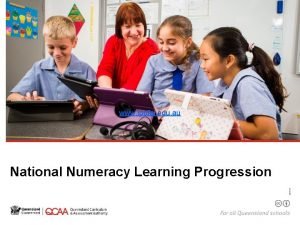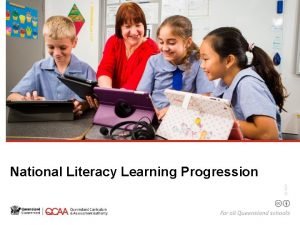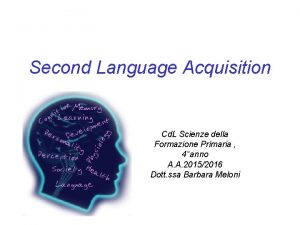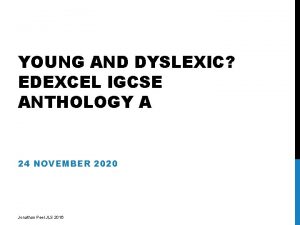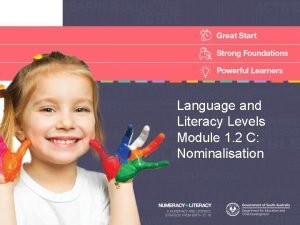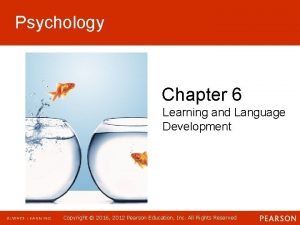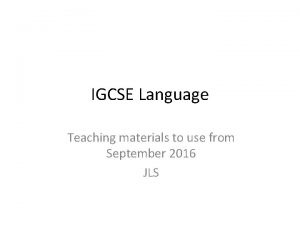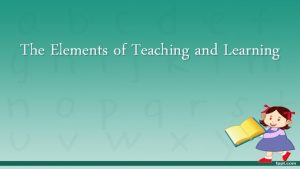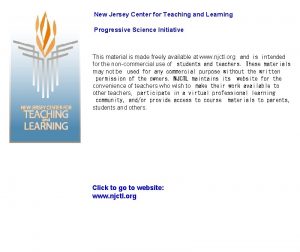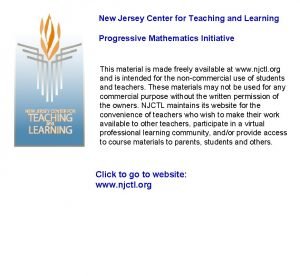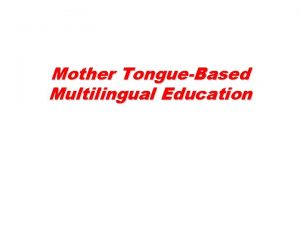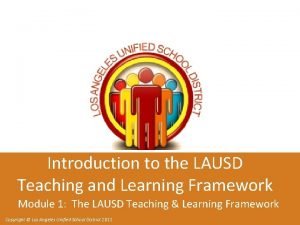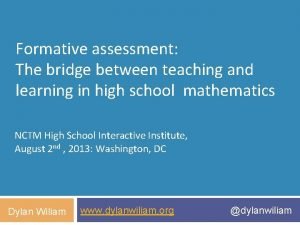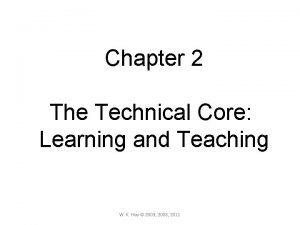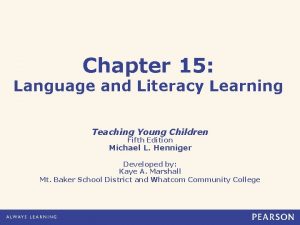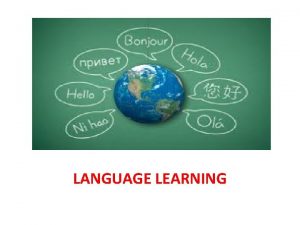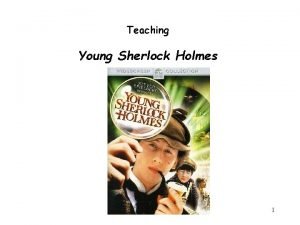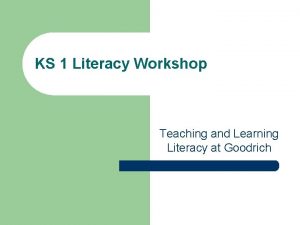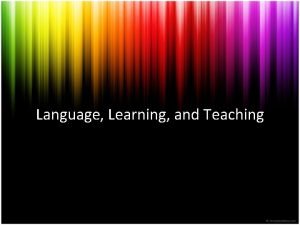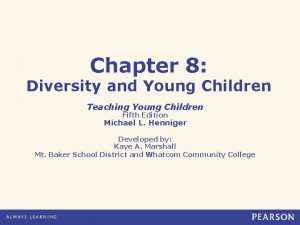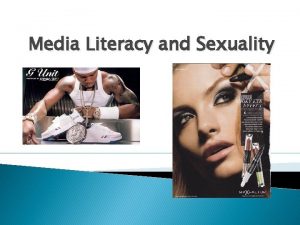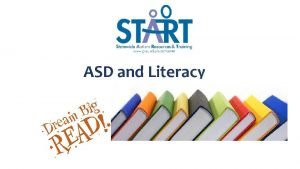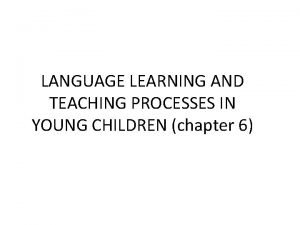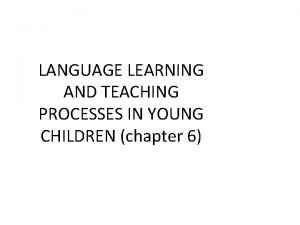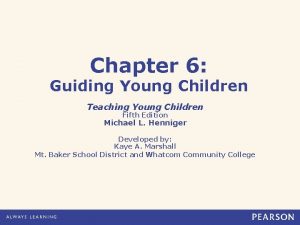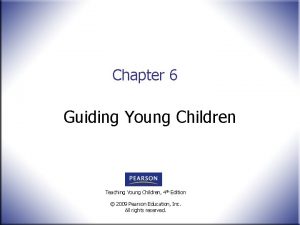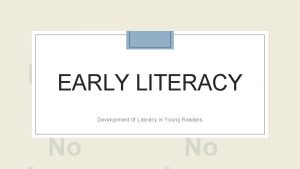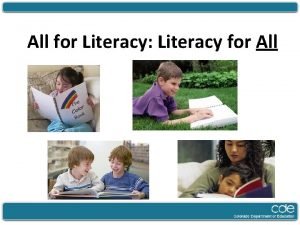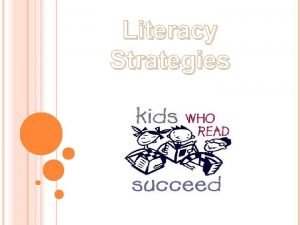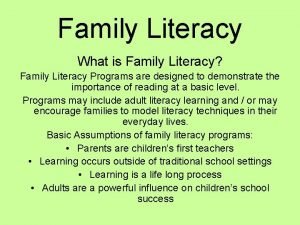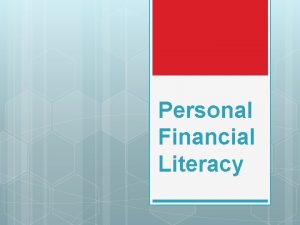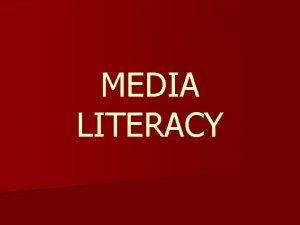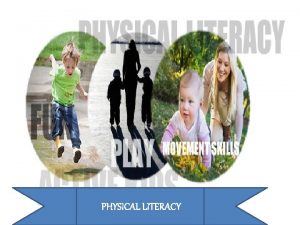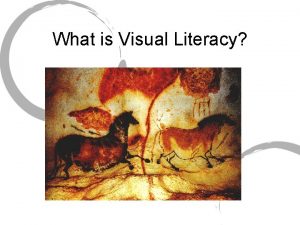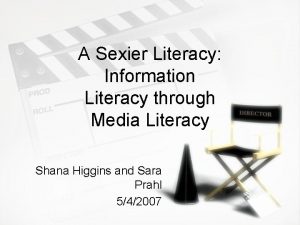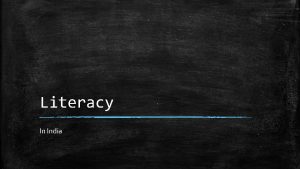Chapter 15 Language and Literacy Learning Teaching Young























- Slides: 23

Chapter 15 Language and Literacy Learning Teaching Young Children, 4 th Edition © 2009 Pearson Education, Inc. All rights reserved.

Goals of Chapter 15 n n n Investigate the development of language in young children Differentiate among the many linguistic systems children must master to understand language Study techniques for facilitating language learning Develop an understanding of the young child’s emerging reading and writing skills Review effective techniques and materials for language and literacy learning Teaching Young Children, 4 th Edition Henniger 2 © 2009 Pearson Education, Inc. All Rights Reserved.

Language Learning n Theoretical perspectives n n Behaviorism Maturationist Language acquisition device Interactionist theory of language acquisition Teaching Young Children, 4 th Edition Henniger 3 © 2009 Pearson Education, Inc. All Rights Reserved.

Language Development n Infancy n n Toddlerhood n n Holophrastic speech, telegraphic speech The preschool years n n Crying, cooing, babbling Understanding expands rapidly, vocabulary increases, sentences more complex, becoming proficient at holding conversations The primary grades n Mastering grammar, learning about humor, multiple meanings, and intonation Teaching Young Children, 4 th Edition Henniger 4 © 2009 Pearson Education, Inc. All Rights Reserved.

Linguistic Systems n n Phonology – system of sounds Morphology - rules for combining sounds to form words n n n Semantics – meanings given to words Syntax – procedure for combining words Pragmatics – understandings necessary for adapting language to different social situations Teaching Young Children, 4 th Edition Henniger 5 © 2009 Pearson Education, Inc. All Rights Reserved.

Facilitating Language Learning n Informal conversations n n n n Show interest by listening carefully Use open-ended questions Build language into routines Model good communication, speak courteously, use good grammar and word choices Build on interests as you communicate Expand vocabulary by using words children may not know Be sensitive to children Teaching Young Children, 4 th Edition Henniger 6 © 2009 Pearson Education, Inc. All Rights Reserved.

Facilitating Language Learning Through Play n n Play provides numerous opportunities for language learning Metacommunication statements Linguistic competence Developing language skills through physical activity – Celebrating Play Teaching Young Children, 4 th Edition Henniger 7 © 2009 Pearson Education, Inc. All Rights Reserved.

Facilitating Language Learning Through Language Rich Experiences n n Exciting adventures Field trips Community involvement The power of story telling n n n Round-Robin or sentence stories Theme stories Descriptive stories Picture stories Grab bag stories Second language learning Teaching Young Children, 4 th Edition Henniger 8 © 2009 Pearson Education, Inc. All Rights Reserved.

Language Learning Materials n n Teaching Young Children, 4 th Edition Henniger Flannelboard stories Magnet boards Puppets Dramatic play props 9 © 2009 Pearson Education, Inc. All Rights Reserved.

Literacy Learning n Literacy Development n Traditional View – language and literacy are different n Emerging literacy – learning to read and write has much in common with oral language development n Phonemic awareness – conscious awareness that speech is composed of identifiable units n Formal literacy instruction n n Phonics instruction Whole language approach Teaching Young Children, 4 th Edition Henniger 10 © 2009 Pearson Education, Inc. All Rights Reserved.

Assisting with Emergent Literacy n Print rich environments n n n A variety of materials for reading Diverse writing materials Displays of children’s written products Integrated print materials Literacy as part of routines Teaching Young Children, 4 th Edition Henniger 11 © 2009 Pearson Education, Inc. All Rights Reserved.

Assisting with Emergent Literacy (continued) n Making the oral and written language connection – language experience approach n n n Group experience stories Individual experience stories Newspaper Teaching Young Children, 4 th Edition Henniger 12 © 2009 Pearson Education, Inc. All Rights Reserved.

Literacy Learning Through Play Linking reading and writing in n Dramatic play activities n n Restaurant play Construction play n Block play Each center should be equipped with literacy related materials. Teaching Young Children, 4 th Edition Henniger 13 © 2009 Pearson Education, Inc. All Rights Reserved.

Reading to Children n n n Read to children when they are in the mood Choose a book appropriate to the age of the children Read stories of interest to you as well Have special reading times as part of the routine of the day Allow children to assist you in reading Use your voice to show interest and to help tell the story Teaching Young Children, 4 th Edition Henniger 14 © 2009 Pearson Education, Inc. All Rights Reserved.

Children’s Books n Resources for building a library n n n Commercial publishers Used bookstores Garage sales Public literacy sales Parent donations Selecting books n n Teaching Young Children, 4 th Edition Henniger Attention span, maturity, interest Broad literacy and artistic tastes Writing style Educational value 15 © 2009 Pearson Education, Inc. All Rights Reserved.

Books for Infants and Toddlers Rhythmical language books n Point and say books n Touch and smell books n Board books n Early picture storybooks n Teaching Young Children, 4 th Edition Henniger 16 © 2009 Pearson Education, Inc. All Rights Reserved.

Books for Preschool and Primary Children Action books n Information books n Picture books n Predictable books n Storybooks n Wordless books n Beginning chapter books n Teaching Young Children, 4 th Edition Henniger 17 © 2009 Pearson Education, Inc. All Rights Reserved.

Writing Tools n n n Magnetic boards Paper and writing instruments Child-sized chalkboards Tracing materials Typewriters Computers Teaching Young Children, 4 th Edition Henniger 18 © 2009 Pearson Education, Inc. All Rights Reserved.

Writing Instruction n n n Children need to chose their own topics Writing should be done for real audiences Focus on what the writer wants to tell others Opportunities for many drafts Provide plenty of time and opportunities to talk about their writing Teachers should provide opportunities to engage in a variety of writing categories Teaching Young Children, 4 th Edition Henniger 19 © 2009 Pearson Education, Inc. All Rights Reserved.

Formal Reading Instruction n n n Daily reading experiences Systematic code instruction Daily writing experiences Small group work Challenging curriculum Individualized instruction Teaching Young Children, 4 th Edition Henniger 20 © 2009 Pearson Education, Inc. All Rights Reserved.

Encouraging Family Involvement n Family Partnerships – involving families in reading n n Provide rationale for reading Suggest good children’s literature Prepare reading backpacks Conduct parent meetings Teaching Young Children, 4 th Edition Henniger 21 © 2009 Pearson Education, Inc. All Rights Reserved.

Observing Development – Early Reading Experiences n Observe n n Reflect n n Go to My. Education. Lab and select “Emerging Literacy and Language Arts” and watch the video “Peer Scaffolding”. How did the older peer’s reading influence the ELL student? Apply n Identify ways that older readers can positively influence younger ones. Teaching Young Children, 4 th Edition Henniger 22 © 2009 Pearson Education, Inc. All Rights Reserved.

Multimedia Exploration and Activities… n Research n n Reflect n n Go to My. Education. Lab and select “Diverse Learners” then watch the video “Sensitive Illustrations”. What did the video tell you about how books can support multicultural education? Respond n Give yourself a small budget and see if you can purchase several good books for your future classroom. Teaching Young Children, 4 th Edition Henniger 23 © 2009 Pearson Education, Inc. All Rights Reserved.
 Venn diagram of media information and technology literacy
Venn diagram of media information and technology literacy Berlo's model of communication
Berlo's model of communication How was mr nestor punzalan affected by being wrongfully
How was mr nestor punzalan affected by being wrongfully Cyber literacy and digital literacy
Cyber literacy and digital literacy Microteaching is a scaled down teaching
Microteaching is a scaled down teaching Cuadro comparativo e-learning y b-learning
Cuadro comparativo e-learning y b-learning How to teach grammar to young learners
How to teach grammar to young learners Teaching young learners english
Teaching young learners english Numeracy continuum qld
Numeracy continuum qld Literacy learning progressions
Literacy learning progressions Scienze della formazione
Scienze della formazione Analysis of young and dyslexic
Analysis of young and dyslexic Language and literacy levels
Language and literacy levels Chapter 6 learning and language development
Chapter 6 learning and language development Psychology chapter 6 learning
Psychology chapter 6 learning Second language vs foreign language
Second language vs foreign language Significant cigarettes igcse
Significant cigarettes igcse Appetitive faculties
Appetitive faculties New jersey center for teaching and learning
New jersey center for teaching and learning How many total squares are there
How many total squares are there Guiding principles for teaching and learning in mtb-mle
Guiding principles for teaching and learning in mtb-mle Lausd teaching and learning framework
Lausd teaching and learning framework Assessment the bridge between teaching and learning
Assessment the bridge between teaching and learning Technical core meaning
Technical core meaning








